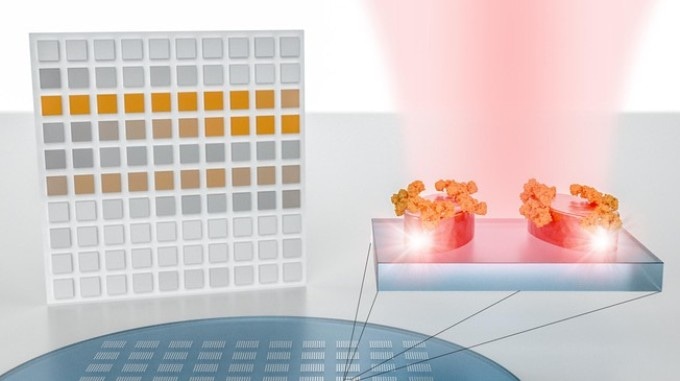Jun 11 2018
EPFL scientists have developed a unique system that can be used for detecting and analyzing molecules with very a level of high precision and without using any bulky equipment. This latest development paves the way for large-scale, image-based detection of materials assisted by artificial intelligence. The study has been reported in Science.
 © 2018 EPFL
© 2018 EPFL
Organic compounds are typically detected and analyzed by infrared spectroscopy, but this method calls for complex procedures as well as huge and costly instruments which make device miniaturization quite difficult and thus limits its applications in certain medical and industrial applications and for collecting data out in the field, for example, for determining the concentrations of pollutants. Infrared spectroscopy is also essentially restricted by low sensitivities and thus needs large amounts of samples.
Conversely, a research team from EPFL’s School of Engineering and Australian National University (ANU) has designed a sensitive and compact nanophotonic system that is capable of identifying the absorption characteristics of a molecule without using traditional spectrometry. The researchers have already detected organic compounds, polymers, and pesticides with their system, which can also be used with CMOS technology.
The novel system features an engineered surface which is surrounded with countless numbers of very small sensors known as metapixels. These metapixels can create a unique bar code for each molecule that the surface comes into contact, and using advanced pattern recognition and sorting technology (for example, artificial neural networks) these bar code can be extensively analyzed. This study - which turns out to be a meeting point of nanotechnology, physics, and big data - has been reported in the Science journal.
Translating Molecules into Bar Codes
Each chemical bond in organic molecules has a unique orientation and vibrational mode, which have an impact on the way molecules absorb light, providing a unique “signature” to each molecule. Infrared spectroscopy determines whether a given molecule exists in a sample by observing if light rays are absorbed by the sample at the signature frequencies of the molecule. Analyses such as these, however, require huge lab instruments that are quite expensive.
The innovative system created by the EPFL researchers is not just more sensitive, it can also be miniaturized; nanostructures with the ability to trap light on the nanoscale are used in the system, thus enabling extremely high detection levels for samples on the surface. “The molecules we want to detect are nanometric in scale, so bridging this size gap is an essential step,” stated Hatice Altug, one of the coauthors of the study and head of EPFL’s BioNanoPhotonic Systems Laboratory.
The nanostructures in the system are classified as the so-called metapixels such that each one resonates at a distinctive frequency. If a molecule makes contact with the surface, light absorption characteristic of the molecule alters the behavior of all the metapixels it touches.
“Importantly, the metapixels are arranged in such a way that different vibrational frequencies are mapped to different areas on the surface,” stated Andreas Tittl, lead author of the study.
This leads to the creation of a pixelated map of light absorption that can be transformed into a molecular bar code - completely without the need for a spectrometer.
“Thanks to our sensors’ unique optical properties, we can generate bar codes even with broadband light sources and detectors,” stated Aleksandrs Leitis, a coauthor of the study.
This innovative system can be used for various potential applications. “For instance, it could be used to make portable medical testing devices that generate bar codes for each of the biomarkers found in a blood sample,” stated Dragomir Neshev, another coauthor of the study.
Artificial intelligence can be combined with this innovative technology to generate and process a whole archive of molecular bar codes for compounds as varied as DNA and protein to polymers and pesticides. Hence, researchers will have a new tool for accurate and rapid detection of trivial amounts of compounds contained in complex samples.